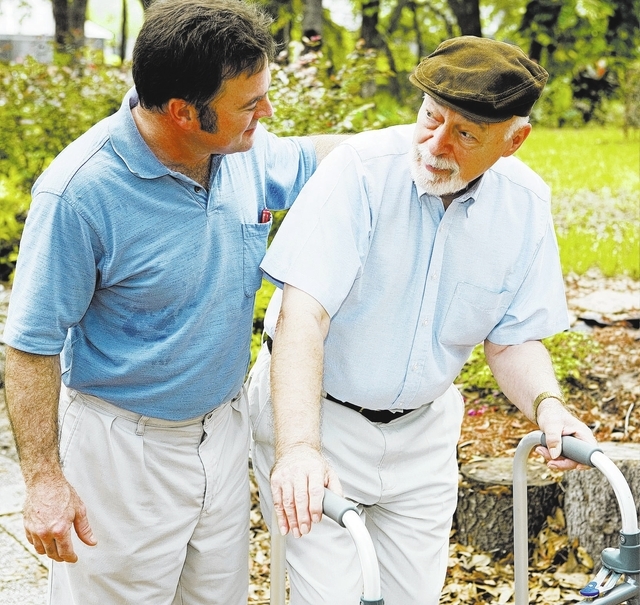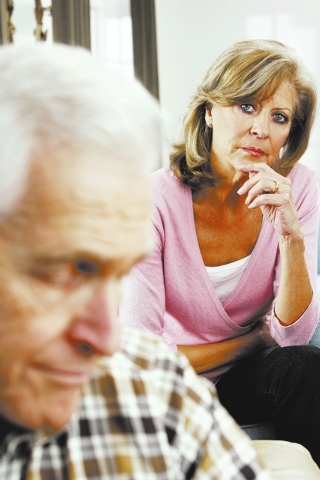Care for caregivers
“If you are traveling with a child, put your oxygen mask on first before helping the child.” — From the preflight safety instructions given by most airlines in case of oxygen emergency.
How counterintuitive. In a dangerous situation, any parent’s first instinct is to protect his or her child. Yet, the advice is sound: If the caregiver is incapacitated, who will help the child?
Caregivers, the hidden health care providers
A recently completed census found 878,194 licensed physicians in the United States. The American Nursing Association reports there are 3.1 million registered nurses. Add to these the many allied health workers and there are probably a couple million more professionals delivering health services in some form.
But there is a hidden health care segment: those who have the usual responsibilities of everyday life, but must also care for a loved one who is ill or aging. According to the National Alliance for Caregiving and AARP, “more than 65 million people, 29 percent of the U.S. population, provide care for a chronically ill, disabled or aged family member or friend during any given year and spend an average of 20 hours per week providing care for their loved one.” (Try to hire enough staff to cover that workload!)
These providers act out of love and are not compensated. Their help is crucial to those for whom they care. But it takes a toll. Charles R. Figley, author of “Compassion Fatigue,” said, “There is a cost to caregiving.”
Susan Reinhard, AARP senior vice president of public policy, estimated the value of the “free” services provided by family caregivers in 2009 at $450 billion. That same year $509 billion was spent on Medicare. On top of that, the Metlife Mature Market Research Institute estimates the lost wages, Social Security benefits and private pensions for caregivers older than 50 at almost $3 trillion.
Caregivers who responded to the 2009 Behavioral Risk Factor Surveillance System reported fair or poor self-related health, more frequent physical distress, more frequent mental distress and being dissatisfied or very dissatisfied with life. The survey is important because “family members … will continue to be the primary caregivers for those with illness or disabilities.” Some researchers are calling caregiving the next public health issue.
Susan Geffen Mintz, co-founder of the National Family Caregivers Association, even has a name for the problem: caregiver disorder. The symptoms are depression, frustration, isolation, stress and other health problems stemming from loss of leisure. Indeed, about 20 percent of caregivers develop medical problems as a result of their caregiving. Stressed out caregivers often resort to unhealthful behaviors: poor diet, smoking and alcohol consumption.
There sure is a cost to caregiving. It comes out of caregivers’ wallets and out of their hides.
Education, attention and support
Over the past decade a body of literature has grown on what caregivers need and how to provide it. There is a remarkable consistency to the advice.
Take care of the practical matters. There are some documents that every caregiver should have and they should be prepared while the loved one is mentally able to do so.
A durable power of attorney allows the caregiver to make legal decisions for the loved one who has become incapacitated. An advance directive sets out the patient’s wishes on end-of-life issues. A health care proxy empowers one designated caregiver to make medical decisions when the patient can no longer do so.
Seek, accept and, when necessary, demand outside help. A recurring theme in the literature of care for caregivers is, don’t be embarrassed or afraid to ask for support.
There are many services available to the family caregiver. There are professionals, usually social workers, who can tell you about them, help you take advantage of them and make you feel good about using them.
Several associations have been founded specifically to support you. Some of the bigger ones are the National Family Caregivers Association (caregiveraction.org); the Family Caregiver Alliance (www.caregiver.org/caregiver/jsp/home.jsp); and the National Family Caregiver Support Program at theHealth and Human Services Department’s Administration on Aging (aoa.gov/aoa_programs/hcltc/caregiver/). All provide advice, information and opportunities to share stories with other caregivers.
Beyond these, you can ask family members for help with tasks such as grocery shopping, cleaning and respite care. And when things are not done in a way you would have done, don’t be critical. Accept the help and be happy for the time you have to care for yourself.
Take charge of your life. Misfortune can strike anyone. The trick is in how you respond. You may not like the new range of choices available to you, but they are choices nonetheless. When you consciously decide to take charge and act, some sense of control returns and you feel less like a victim. This will affect your outlook and approach to your situation.
Take care of yourself. When a relative of ours was in her final days, her spouse resolved to stay by her bedside 24/7 until the end. The doctors reminded him that if he did not take care of himself, he would eventually give out and there would be no one to fulfill his role for the patient (it’s like the parent on the aircraft putting their own oxygen mask on first!).
It has been proved that lack of leisure causes physical and mental breakdown. Nobody can run on adrenalin forever. Do what you must to refresh and restore yourself because you have important work to do and you have to be sharp.
Fight fear with information. Talk to the medics and be persistent until they answer your questions so you understand. Participate in support groups, both online and in person. These often exchange information found nowhere else and, literally, support each other just by listening and being present.
Contrary to what we are often told, the government can help. As awareness of caregiver issues has risen, states have created programs to help. See if your state is one of the 17 that offers tax credits for at-home care expenses, and income tax breaks for employer-provided assistance.
Take advantage of the federal Family Leave law, but be aware that 11 states have more generous leave policies than the feds. See if you live in one of them. Thirty-eight states cover respite care and 40 states provide for adult day care. Many states pay relatives for providing home care. Other states have specific programs to help caregivers. Do the research.
What do the pros do?
It is well-documented that doctors and nurses feel the stress of caregiving, too. And the effects of “clinician stress” can have significant negative effects on patient care.
A survey of 7,905 surgeons yielded some disturbing findings. Sixty-four percent said their work schedule left little time for family life. Forty percent reported burnout. Another study found 53 percent of physician respondents reporting moderate to severe levels of stress. One survey of nurses reported 26 percent saying they left the profession because of stress.
There is a clear link between clinician stress or emotional exhaustion and medical errors. In one study of internal medicine residents, 39 percent of respondents reported medical errors because of fatigue and distress.
Stress can damage communication between physicians and nurses, negatively affecting the delivery of care. So what happens when physicians deliver less than optimal service? In most cases the result is a negative comment on the annual evaluation. These have been shown to be decidedly unhelpful.
Enlightened hospital administrators are offering clinicians tools to manage stress and creating environments that improve communication, restore authority and autonomy, and eliminate punitive practices — far better ways to eliminate medical errors.
Those who care for the dying
The Karen Ann Quinlan Hospice in Newton, N.J., is known internationally for the care it provides and for its work in the hospice movement. Hospice is for patients “for whom palliative care is indicated.” Translation: this patient will usually die within six months or so. Hospice workers have the almost superhuman task of caring for a dying patient and their family caregivers at the most difficult of times.
Marlina Schetting, director of social services at Karen Ann Quinlan Hospice, told us about some of the things she sees in family caregivers with whom the hospice works.
When hospice first encounters family caregivers, they are in crisis; they are tired and they are coming to the devastating realization that the end is near. Many still have to hold down a job, and family members who could help often live far away. Some are in the “sandwich” generation: middle-aged people who care both for children and an aging parent.
Schetting cites Elisabeth Kubler-Ross’ five stages of dying — denial, anger, depression, bargaining and acceptance. Families and caregivers of the dying go through the same roller coaster and not necessarily in a linear way. A person might be in denial one minute and acceptance the next.
Empathetic pain is not uncommon; often, if a loved one is in pain, the caregiver is in pain vicariously.
How do you handle this stuff?
Karen Ann Quinlan Hospice takes a holistic approach, including the family caregiver as part of a team that includes nurses, social workers and pastoral care specialists. They gradually win the confidence of the family caregiver so that he or she feels comfortable making use of the staff.
And, they look for the positive. Even though a person is dying, they can still have goals — a comfortable death at home, seeing a grandchild born, an event they want to experience. The caregiver can feel good about achieving these goals for their loved one.
In 15 years as a hospice nurse, Beth Sylvester has helped more than 1,000 patients and their families. She acknowledges “There are days when I cry and I say, my God, how can I do this anymore? But I do take care of myself. I exercise. If I am really having a down situation I use the team here, the social workers or the bereavement support group.
“And hospice nurses have a sense of humor. Some people might think this crude, but it’s really not. It gets us through the day. I was working with a dying man who really needed some mouth care. I got on the bed to take out his false teeth. One of the last things he said was ‘They’re real.’ ”
“I tell the families, ‘this is the final gift you are giving your loved one. Go take that hour and a half off. Take that walk. You’re going to need that time to regroup and refresh, just like we do, so that you can take care of your loved one.’
“My mentor has always said, ‘You only get to die once. You better get it right.’ We are there to make sure you get it right.”
November is National Family Caregivers month, a time to celebrate the enactment of the National Family Caregiver Support Act, which has benefited more than a half million family caregivers.
In his proclamation for the 2012 celebration, President Barack Obama called the month “… a time to reflect on the compassion and dedication that family caregivers embody every day. As we offer our appreciation and admiration for their difficult work, let us also extend our own offers of support to them and their loved ones.” We agree.





























